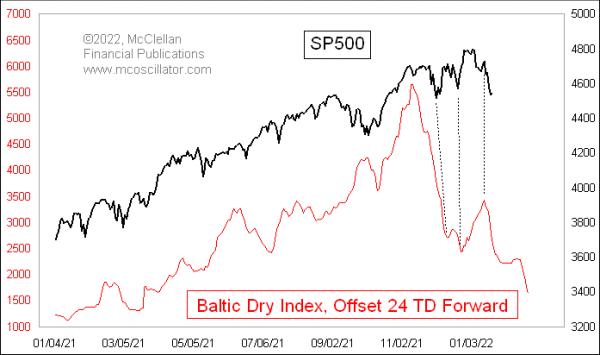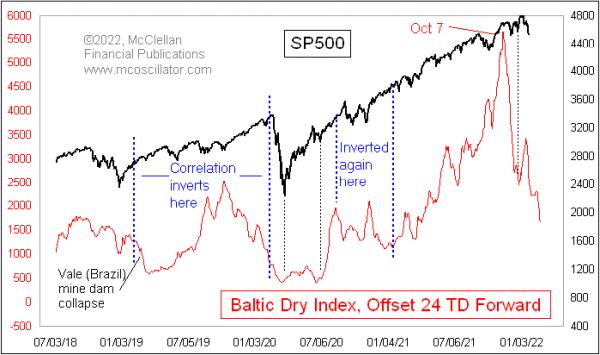
The Baltic Dry Index (BDI) peaked back on October 7, 2021 and has fallen by 72% since then, as worldwide demand has fallen rapidly for cargo ships to haul iron ore and other "dry" cargos. This has a bearish implication for stock prices, illustrated in this week's chart. The trick is that the plot of the BDI is shifted forward by just over a month to reveal how its movements get repeated by the S&P 500.
I don't really know why this relationship works, nor why 24 trading days gets the best fit between the patterns. I don't believe that ship owners "cause" the movements of the stock market. But liquidity waves flow through all markets and ripple out toward other ones. For whatever reason, the international shipping markets seem to get early indications of the liquidity waves that are going to subsequently hit the stock market. The magnitudes of the movements are different, obviously, but I care more about the timing of the dance steps than I do about how loud they are.
The immediate implication of this BDI decline is that a corresponding decline in stock prices should still have more to go. But before you go and start counting your chickens on how to make money shorting the stock market, there is an important point to remember, which is that this relationship can be a fickle one. Here is a longer-term chart:

The lagged correlation seems to be working positively right now, for the most part, but, for all of 2019, the two plots were inverted. An inversion happened again in late 2020. I do not know why this relationship works in the first place, and so I definitely do not know what factor might cause it to invert and then disinvert later. I can just see that this happens.
For that 2019 inversion, the arrival of the COVID Crash seems to have jolted the correlation back to positive again, like a defibrillator for a heart attack patient. And perhaps the COVID-related work restrictions are behind the inversion that we saw in late 2020. I have not figured out a good way to determine when another inversion might occur.
The key takeaway from this relationship is that, while it is a fascinating one and we can pay attention to it among the other indications we watch, it is not something which merits our complete trust. Anything that can invert like this must be treated with some suspicion.
